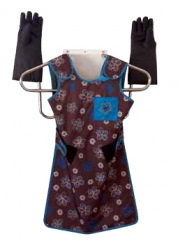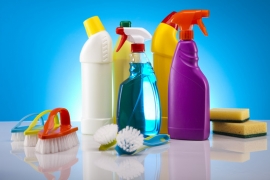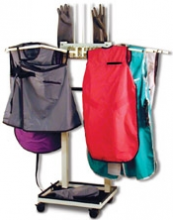Proper X-Ray Protective Apron Care and Use
X-ray aprons serve a very specific purpose, to protect and shield you from the potentially harmful effects of ionizing radiation. Shielding, one of the three concepts of basic radiation safety, should always be used when the use of time and distance principles are not possible.Protective x-ray aprons constructed of lead or a non-lead equivalent are designed to protect the radiosensitive areas of the body when it is necessary for the healthcare worker to be near the source of radiation. Typically, x-ray aprons will offer frontal protection of 0.5 mm lead equivalency. In some instances, wrap-around x-ray aprons are required when medical personnel will have their backs exposed to the radiation source.
By learning the proper way to maintain and care for your x-ray apron, you will ensure that you are properly protected and you will extend the life of the apron. Below are the four do’s and the five don’ts of proper x-ray apron care. After reading this post, you will know how to keep your x-ray apron looking good while also keeping yourself protected against the harmful effects of ionizing radiation.
X-Ray Protective Apron Do’s
1. Inspect and Check Apron For Defects, Cracks, Creases, and Perforations
Place the x-ray apron on a flat surface and visually check all the seams as well as the outer and inner covers of x-ray apron for any visible damage. Next, check the belts and fastening devices to confirm that they are in good condition. Lastly, inspect the surface of the apron with your hands to locate any potential lumps, cracks, sagging or separation from the apron seams. If the apron condition appears to be suspect, it should be inspected radiographically. “Rejecting an apron depends on the location, area size and number of flaws. It is best to keep the number of flaws to a minimum. ¹ [ ncradiation.net/xray/documents/leadapronsgud.pdf ]
Note: It is recommended that you follow the manufacturer’s recommendations and/or the state regulations regarding the proper care and use of lead protective equipment.
2. Clean Regularly
X-ray Aprons should be cleaned daily and deodorized by scrubbing with a soft bristle brush, using cold water and a mild detergent. Completely remove cleaning residue by thoroughly rinsing with clean, cold water.
Apron Cleaning Tips
To ensure x-ray aprons are not damaged while cleaning, follow these helpful tips:
- Never use products that contain bleach.
- Do not soak or submerge x-ray apron in water.
- Do not machine launder, autoclave or dry-clean.
- Once cleaning is complete, if possible, hang the apron on the designated apron wall rack to air dry.
3. Properly Store X-Ray Aprons
The x-ray apron manufacturer’s recommendation regarding the proper handling and storage of the apron must be strictly observed. When not in use x-ray aprons must be stored on hangers to prevent cracks in the protective lead. If possible, do not store the x-ray apron on a flat surface. Aprons should be hung by the shoulder or on an approved apron hanger. Aprons should never be folded or creased, to avoid damaging the lead. “Cracks in the lead lining can develop at the fold, reducing the useful life of the apron.” ¹ [ ncradiation.net/xray/documents/leadapronsgud.pdf ] Hook and loop fasteners must be secured properly to avoid snagging or tearing of fabric, always store apron with fasteners completely secured.
4. Dispose Of Lead Aprons Properly
X-ray protective aprons that contain lead cannot be disposed of as municipal solid waste. Consequently, they must be disposed of as hazardous waste or recycled. The Environmental Protection Agency encourages recycling and reuse rather than disposal. According to the EPA, if the lead shield or apron can be reused by another business for its intended purpose then it remains a product, therefore it is not classified as waste or hazardous waste. Recycling the lead apron is the preferred method since it keeps the lead out of the landfill and extends the useful life of the lead apron. When recycling is not an option, you can contact a disposal service to properly dispose of the lead material.
X-Ray Protective Apron Don’ts5. Sit While Wearing Your Apron
Unless the x-ray apron has been designed specifically for seated procedures, you will want to avoid sitting while wearing your apron. Cracks in the lead lining can develop while wearing the apron if seated. Also, you will want to avoid sitting on the apron for the same reason.
6. Expose Apron To Extreme Temperatures
To prevent damage to the apron, you will want to avoid exposing your x-ray apron to extreme hot or cold temperatures or to direct sunlight.
7. Lean Against Pointed Objects or Sharp Edges
Avoid storing sharp objects in the pockets. X-ray aprons can become damaged while leaning up against sharp or pointed objects, creating perforations in the lead lining and reducing the attenuating qualities of the lead.
8. Store Aprons Over Chair Backs or Equipment
Laying aprons over a chair back or piece of equipment can create creases in the lead lining and can reduce the useful life of the apron.
9. Fold Aprons
To prevent damage to the lead lining, avoid folding, wadding or creasing your x-ray apron.
Ensure Reliable Performance
To ensure safe performance, as well as keeping your x-ray apron looking good for years to come, we strongly recommend that each x-ray protective apron is thoroughly inspected upon receipt and at regular intervals and properly stored when not in use.
X-ray aprons should be evaluated every 18-24 months to determine if replacement is needed, depending on the amount of usage and general wear and tear. If you found this post helpful, please feel free to share this post or our SlideShare presentation with your colleagues.
//www.slideshare.net/UniversalMedicalInc/x-ray-protective-apron-care-9-dos-and-donts



Leave a Reply